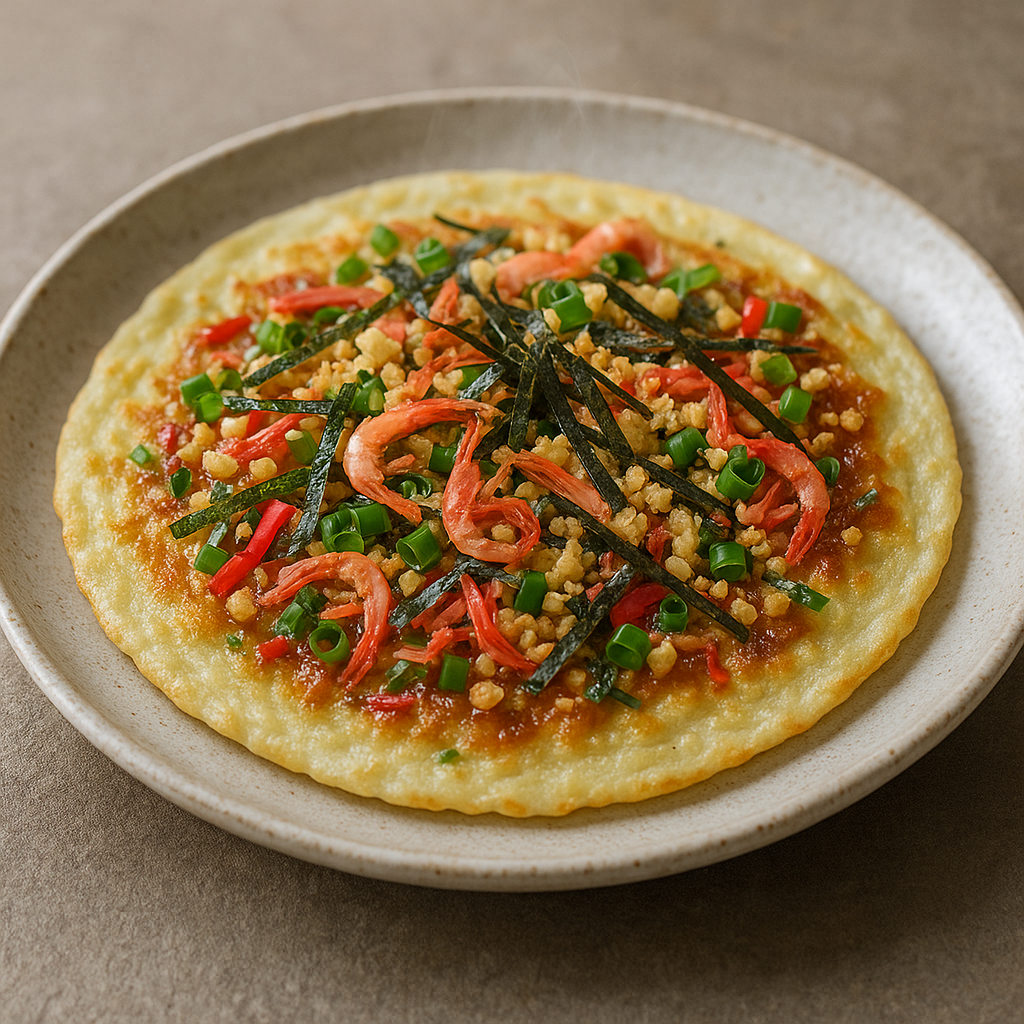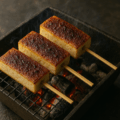うす焼き(岩手)の特徴
薄くのばした生地に具を散らし、しょうゆで香ばしく仕上げます
うす焼きは、小麦粉の生地を薄く焼き、ねぎ・紅しょうが・桜えび・天かす・海苔などをのせて焼き上げ、仕上げに表面へしょうゆを塗って香りを立たせる盛岡の郷土食です。もっちり感と紅しょうがのアクセント、桜えびの風味が軽やかに広がります。
祭礼の屋台で親しまれ、くるくる巻いて供することもあります
盛岡八幡宮の祭礼や初詣などで屋台の定番として親しまれてきました。焼き上げたうす焼きをくるくると巻いて手渡すスタイルも見られます。
うす焼き(岩手) レシピ
材料(5人分・小判10枚目安)
- 薄力粉 … 200g
- 水 … 320〜360ml(生地ののびで加減)
- 塩 … ひとつまみ
- (好みで)片栗粉 … 大さじ1(もっちり補強)
- 長ねぎ(小口切り) … 1本分
- 紅しょうが(刻み) … 40g
- 桜えび(乾) … 20g
- 天かす … 40g
- 焼き海苔(細切り) … 適量
- しょうゆ … 大さじ2〜3(塗り用)
- サラダ油 … 適量(焼き用)
作り方
- 1. ボウルで薄力粉・塩(・片栗粉)を混ぜる。水を少しずつ加え、ダマがなくなるまで溶く。
- 2. フライパンを中火で温め、薄く油をひく。生地をおたま1/2杯ほど流して薄く広げる。
- 3. ねぎ・紅しょうが・桜えび・天かす・海苔を手早く全体に散らす。
- 4. 縁が乾いてきたら裏返し、軽く焼き色がつくまで焼く。
- 5. 表に返し、表面にしょうゆを刷毛で薄く塗る。香りが立ったら取り出す。
- 6. そのまま供するか、熱いうちに手前からくるくる巻いて盛り付ける。
シェフのワンポイントアドバイス
- 生地は“やや緩め”が広げやすい。具はのせ過ぎず薄く均一に散らすと破れにくいです。
- 鉄板や厚手フライパンを十分に温めてから焼くと、縁がパリッとします。
栄養価(1人分の目安)
- エネルギー … 220〜320 kcal
- たんぱく質 … 6〜9 g
- 脂質 … 6〜12 g(天かす・油量で変動)
- 炭水化物 … 30〜45 g
- 食物繊維・ミネラル … ねぎ・海苔・桜えび由来
歴史
粉もの文化と屋台の味が形づくりました
小麦粉の生地を薄く焼いて具を散らす素朴な製法は、家庭の鉄板料理と屋台文化の中で親しまれてきました。しょうゆを塗って香ばしく仕上げる所作が特徴です。
盛岡の祭礼で根づいた“ご当地の一枚”です
祭りや初詣の屋台で提供され、くるくる巻いて食べ歩くスタイルも楽しまれてきました。市内の限られた範囲で受け継がれた、地元密着の味として語り継がれています。
English Version
Features of Usu-yaki (Iwate)
Thin batter sprinkled with toppings, finished with soy aroma
Usu-yaki is a local snack from Morioka: a thin wheat-flour batter is griddled, topped with scallions, red pickled ginger, dried sakura shrimp, crunchy tempura bits, and nori, then brushed with soy sauce to release a toasty fragrance. The slight chew contrasts with the zing of ginger and the light seafood notes.
Beloved at festival stalls—often served rolled up
A staple of stalls at Morioka Hachimangu festivals and New Year visits, the sheet is sometimes rolled up and handed to guests for easy eating.
Usu-yaki (Iwate) – Recipe
Ingredients (Serves 5; about 10 small ovals)
- Cake flour … 200 g
- Water … 320–360 ml (adjust for spread)
- Salt … a pinch
- (Optional) Potato starch … 1 Tbsp (for extra chew)
- Long green onion, thinly sliced … 1 stalk
- Red pickled ginger, chopped … 40 g
- Dried sakura shrimp … 20 g
- Tempura bits (ten-kasu) … 40 g
- Nori, shredded … to taste
- Soy sauce … 2–3 Tbsp (for brushing)
- Neutral oil … as needed (for the pan)
Directions
- 1. In a bowl, whisk flour, salt (and potato starch if using). Add water gradually and whisk until smooth.
- 2. Heat a skillet over medium; wipe with a thin film of oil. Pour about 1/2 ladle of batter and spread thin.
- 3. Quickly scatter scallion, red ginger, sakura shrimp, ten-kasu, and nori evenly over the surface.
- 4. When the edge looks dry, flip and cook until lightly colored.
- 5. Flip back, brush the surface lightly with soy sauce, and remove once the aroma blooms.
- 6. Serve as is, or roll up from the near edge while hot.
Chef’s Tips
- A slightly loose batter spreads easily; keep toppings light and even to avoid tearing.
- Preheat a griddle or heavy pan well for crisp edges.
Nutrition (per serving, approx.)
- Energy … 220–320 kcal
- Protein … 6–9 g
- Fat … 6–12 g (varies with oil and ten-kasu)
- Carbohydrates … 30–45 g
- Fiber & minerals … mainly from scallion, nori, and shrimp
History
Shaped by flour cookery and stall culture
The simple method—thin batter with scattered toppings—grew within home griddle dishes and street stalls. Brushing soy on the finished surface is a signature flourish.
A hometown “one-sheet” rooted in Morioka festivals
Popular at festival and New Year stalls, it’s also enjoyed rolled for eating on the go. Locally cherished, it remains a close-to-home taste passed down in the city.



何でも質問してください!